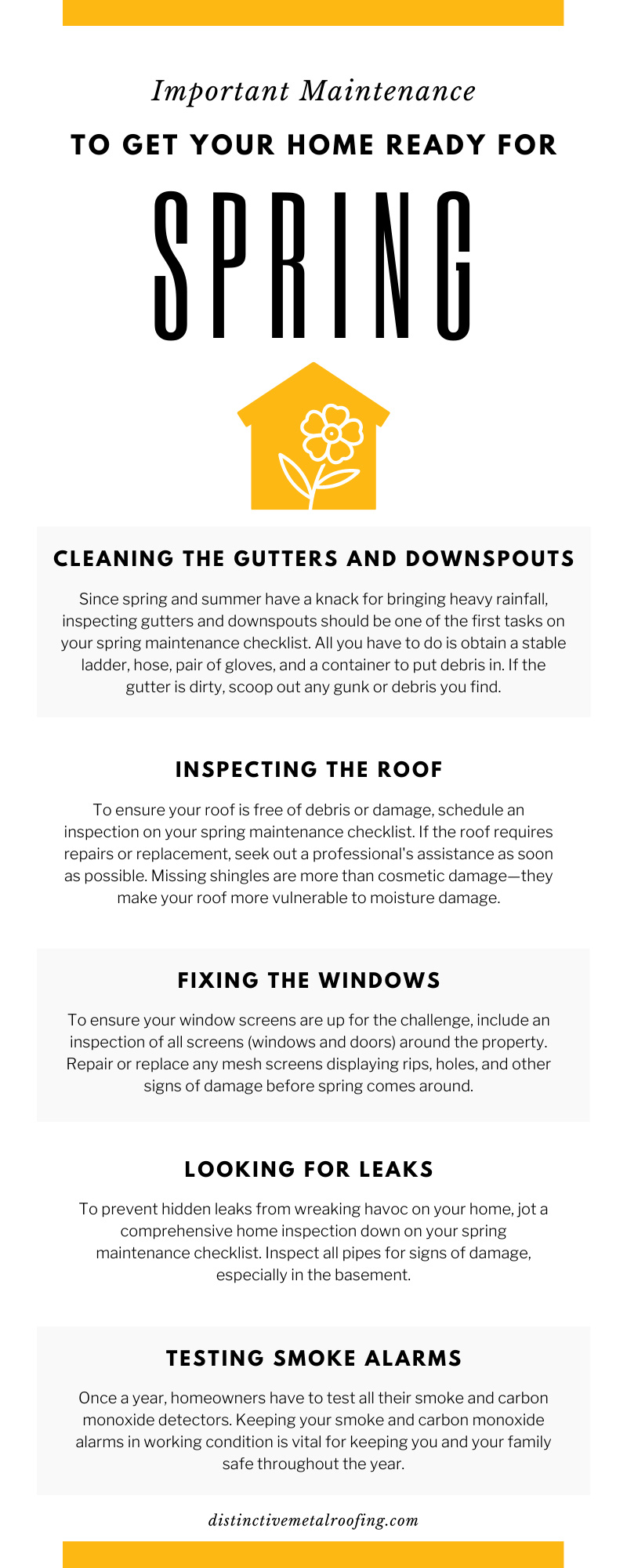
Owning a home is a significant responsibility, to say the least. Whether you’re a first-time homeowner or a long-time one, the level of responsibility property ownership requires should always be very apparent. However, there are so many facets of home upkeep that it’s easy for residents to forget some of the most important tasks. For this reason, many homeowners prefer carrying out annual upkeep around the end of winter or the beginning of spring.
That timeframe is ideal because harsh winter weather can do a number on residential homes thanks to ice dams, moisture damage, and other seasonal hazards. Plus, the spring and summer months pose hazards of their own. Planning out a springtime maintenance checklist allows you to efficiently and thoroughly conduct necessary inspections, cleanings, and so forth each year. This guide will introduce you to five examples of important maintenance to get your home ready for spring.
Cleaning the Gutters and Downspouts
Although gutters run along the roof of your home, they play a key role in preventing water from gathering in the foundation below. The downspouts running down the side of your home function in tandem with gutters to keep the foundation safe and secure. Unfortunately, if your gutters or downspouts are clogging, they’ll overflow after any spring showers.
Not only will that overflowing water hinder your home’s foundation, but it can also lead to your roof and siding enduring water damage. So, why do gutters or downspouts clog? Obstructions such as leaves, twigs, and dirt can accumulate in gutters and downspouts, making it harder for them to divert water away from your foundation safely.
Since spring and summer have a knack for bringing heavy rainfall, inspecting gutters and downspouts should be one of the first tasks on your spring maintenance checklist. All you have to do is obtain a stable ladder, hose, pair of gloves, and a container to put debris in. If the gutter is dirty, scoop out any gunk or debris you find.
Once you remove the obstructions, turn on your hose and wash out the gutters. Not only does this help you remove any lingering gunk, but it also helps you test out the system’s ability to carry water away from your foundation. Consider reaching out to a professional if you have any worries about climbing a ladder to check the gutters.
Inspecting the Roof
Winter is rarely kind to residential roofs, especially if the roof is made from asphalt shingles. Asphalt shingles are popular roofing materials, but they’re susceptible to various weather issues. Heavy winds can loosen these shingles or knock them off a roof entirely. Plus, asphalt roofing is susceptible to ice dam formation and moisture damage—two issues they’ll endure during the winter months.
To ensure your roof is free of debris or damage, schedule an inspection on your spring maintenance checklist. If the roof requires repairs or replacement, seek out a professional’s assistance as soon as possible. Missing shingles are more than cosmetic damage—they make your roof more vulnerable to moisture damage.
Luckily, not all forms of roofing are as susceptible to winter weather hazards as asphalt shingles. Metal roofing is the best material for withstanding harsh weather, making springtime inspections very quick. This is because a good metal roof can shed ice and snow better than asphalt shingles.
Metal roofing can accumulate ice dams, but they’re much less likely to do so than other materials, especially if you invest in high-quality materials and adequate attic ventilation. Additionally, you can experience the benefits of metal roofing that mimics the style and aesthetic of shingles. For example, our team of experts can successfully carry out a metal shingle installation, which gives homeowners a chance to don the layout of shingles without suffering from the many downsides of asphalt roofing.
Fixing the Windows
Once spring arrives, homeowners tend to find insects such as flies, spiders, and ants around their property more frequently than they did during winter. One of the many suitable methods for keeping insects out of your home is installing window screens. These mesh barriers might seem simple, but opening up windows and letting fresh air into your house during summer would be much less comfortable without them.
Installing window screens allows homeowners to open windows on warm evenings without worrying about bugs marching in. To ensure your window screens are up for the challenge, include an inspection of all screens (windows and doors) around the property. Repair or replace any mesh screens displaying rips, holes, and other signs of damage before spring comes around.
Looking for Leaks
Homes have pipes all over the place, which means leaks can develop almost anywhere on the property. To prevent hidden leaks from wreaking havoc on your home, jot a comprehensive home inspection down on your spring maintenance checklist. Inspect all pipes for signs of damage, especially in the basement. Allowing pipes to leak is an easy way to promote mold growth in your home. Don’t forget to include the attic in the inspection too.
Overflowing gutters can cause leaks in the attic, but they’re not the only culprit. From poor ventilation to inadequate roof installation, attics can suffer from leaks for various reasons, so routine inspections are crucial.
Testing Smoke Alarms
Once a year, homeowners have to test all their smoke and carbon monoxide detectors. Keeping your smoke and carbon monoxide alarms in working condition is vital for keeping you and your family safe throughout the year. Testing these devices as part of your annual spring cleaning is a great way to keep this task in mind so you can stay on top of that once-a-year timeframe. If necessary, swap out any smoke or carbon monoxide detector batteries to get these devices ready to provide another twelve months of protection.
Conducting important maintenance to get your home ready for Spring is never something you should put off. If you’re a homeowner who wants to have pride in their home every day, keeping the property functional and attractive is the way to achieve that feeling.
Well in advance of the first day of spring, put your maintenance checklist in order and follow through with each task upon the season’s arrival. Even if you don’t yet see the value in some of these maintenance tasks, their importance will become apparent once you begin carrying them out annually.


